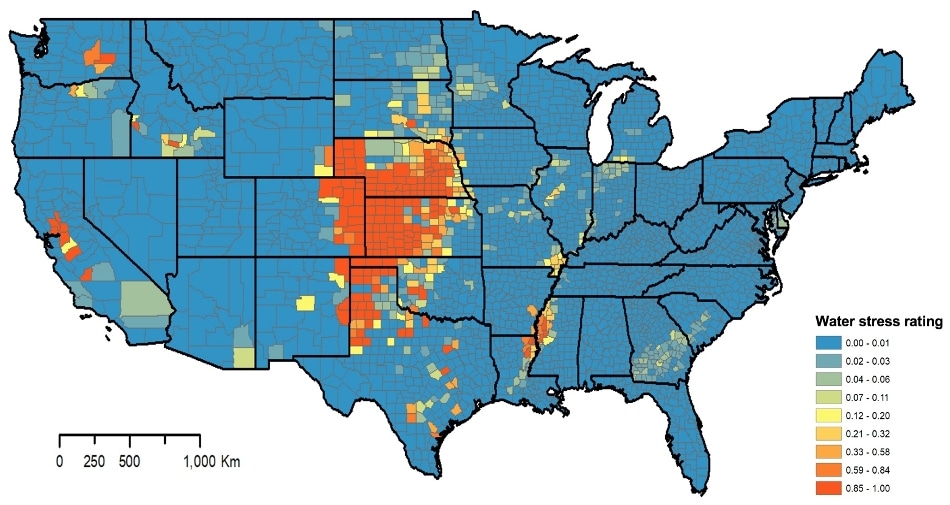May 17 2019
The U.S. Department of Energy’s Argonne National Laboratory recently launched an upgraded version of an online computer model put together to help bioenergy developers preserve vital resources.
 This map depicts water availability by county; areas shown in orange are under higher levels of water stress. (Image credit: Argonne National Laboratory.)
This map depicts water availability by county; areas shown in orange are under higher levels of water stress. (Image credit: Argonne National Laboratory.)
The model, known as Water Analysis Tool for Energy Resources or WATER, has users from over 35 U.S. states.
It offers a comprehensive analysis of water consumption used in the advancement of bioenergy, allowing industry leaders to make well-informed decisions about what kinds of feedstock – meaning the raw materials that bioenergy is composed of, including soybeans, forest wood residues, corn grain, grasses, corn stover, and algae – are most suitable for use in water-limited areas.
Water sustainability is becoming increasingly important when considering our energy future. When evaluating the effects of bioenergy on water, it’s critical that we understand how much water might be consumed, as well as the potential impacts of that water consumption at a regional level. Tools like these keep us working toward meeting the national and global need for secure, affordable water.
Daniel Simmons, Assistant Secretary of the Office of Energy Efficiency and Renewable Energy, U.S. Department of Energy
Argonne’s May Wu, chief environmental systems analyst, programmed the software with the help of three other scientists. The project was sponsored by the U.S. Department of Energy’s Bioenergy Technologies Office within the Office of Energy Efficiency and Renewable Energy.
Competing demands for water create stress in many areas of the U.S., particularly in regions with limited annual freshwater resource inputs like some of the western states. We wanted to know how increased biomass production would affect freshwater availability to non-bioenergy sectors in any given region – and what strategies would be helpful to reduce irrigation demand and alleviate water stress. Water conservation is already a high priority and will only grow more important in the coming years.
May Wu, Chief Environmental Systems Analyst, Argonne National Laboratory
Furthermore, WATER can be used to help bioenergy developers pick where to construct their biorefineries, she said.
This newest version of the software, WATER 4.0, is different from its previous versions in two important ways. First, the new version specifies the amount of water present in various regions of the United States at the county level.
In an attempt to incorporate this vital feature, Wu and her team calculated the yearly freshwater available from stream flow, rainfall, and renewable groundwater and then compared this with the demand for irrigation water under future projected bioenergy production situations.
Second, the new model estimates the freshwater accessible for non-bioenergy sectors such as agriculture, municipal, power, and other industries – besides ecosystem services after bioenergy feedstock water demand is matched.
WATER 4.0 also enables users to concentrate more intensely on various regions of the continental U.S. as each has a diverse availability of water.
The software was initially introduced in 2012 with a pathway-based platform that measured the water footprint of a biofuel from the feedstock growing phase to the fuel production phase at the state, county, and regional level. It concentrated on a number of basic U.S. feedstock types, including conventional corn grain, corn stover, soybean, and wheat straw.
A second version was launched in 2014 that comprised of new pathways of bioenergy production from perennial grasses, such as miscanthus and switchgrass.
Water 3.0, launched 2015, offered another unique bioenergy production pathway, forest wood residue – including softwood and hardwood– and short rotation woody crops.